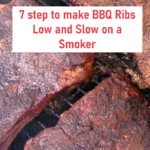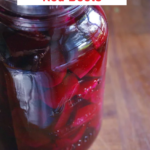Chocolate is a food that is simultaneously ubiquitous and mysterious. Chocolate is everywhere – in cakes, in candies, in beverages. Yet few people really know how chocolate is made. Even fewer have actually set their eyes on a cocoa bean, much less a cocoa pod.
After extensive research, I’ve discovered chocolate’s dirty little secret – it’s a piece of cake to make at home.
And if your family is impressed by homemade truffles and cakes, imagine how they’ll feel when you had them a bar of home-freaking-made chocolate.
Chocolate manufacture requires six steps.
- First comes fermentation and drying. The beans are harvested from the pods, and allowed to naturally ferment over a period of two days to two weeks. Heat kills the delicate germinating seed, and natural yeasts grow to develop complex flavors. The beans are then sun-dried to preserve them for shipping.
- Next, the beans are roasted. Cocoa beans are roasted for the same reason that coffee beans are – to develop complex flavors via the Maillard reaction, and to drive off unpleasant acidic compounds developed in the fermentation process.
- Cracking and winnowing follow roasting. This step is purely mechanical, to separate the valuable nibs from the worthless shells.
- After this, the nibs must be refined. The tongue can perceive particles larger than 30 micrometers in size, so extensive grinding is needed for a good mouthfeel.
- The raw cocoa liquor is then “conched,” a lengthy process which drives off the rest of the acidic flavoring compounds.
- Finally, the finished product is tempered to give the chocolate good gloss and snap.
Unfortunately, cocoa pods are practically impossible to get your hands on. So we’ll (unfortunately) have to start at the second step, with pre-fermented and dried cocoa beans.
Ready? Into the breach we go, my friends!
Or, you can just watch the video. (Which works now! Hooray!)
Step 1: Equipment and Ingredients


The ingredients you’ll want are as follows:
- Cocoa beans. These can be troublesome to find locally. Fortunately, we have the internet! I bought my beans from Chocolate Alchemy, which also has a treasure trove of chocolate making information.
- Something to sweeten the chocolate. You can use any solid sweetener – table sugar, brown sugar, “raw” sugar, splenda, etcetera. Don’t use honey, agave nectar, molasses, or other liquid sweeteners unless you want to end up with a chocolate paste.
- Spices (optional). Since this is your chocolate, you can add whatever you want! Cinnamon and cardamom are delicious. Chili powder is a classic. The sky’s the limit! Curry powder! Wasabi! Coffee! Peppercorns! …even bacon, perhaps.
- If you are planning on tempering the chocolate by seeding, you’ll need a small amount of tempered chocolate.
- Cocoa butter (optional), to thin the final product.
On the equipment side, you’ll need:
- A food processor or spice grinder (blade grinder, not burr grinder).
- A baking sheet (perforated, ideally).
- A hairdryer, heat gun, or shop-vac.
- A bowl.
- A mortar and pestle/molcajete (for smaller batches) or a stand mixer (for larger batches).
- If you’re planning on tempering the chocolate by tabling, you’ll also need a slab of marble, granite, or other smooth nonporous stone surface, and a pair of scraping tools (like these or these).
Step 2: Roasting the Beans
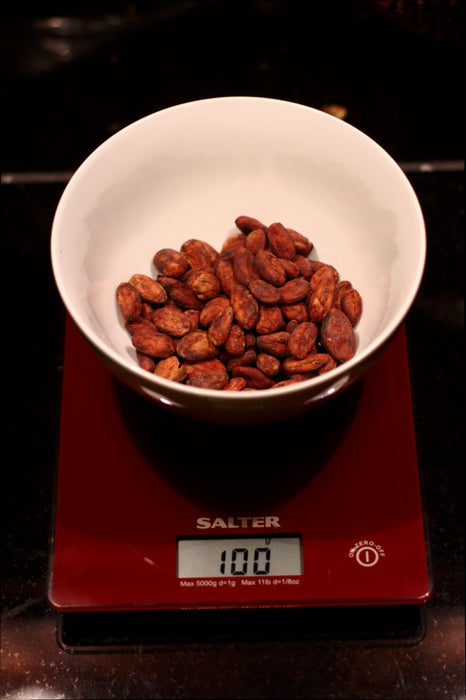
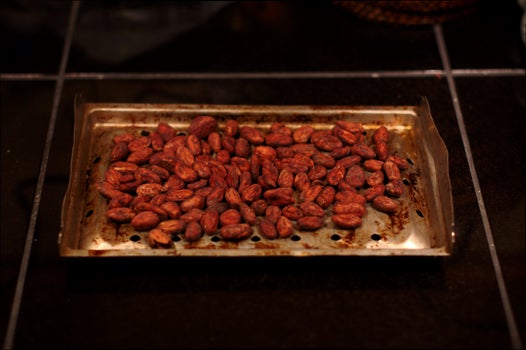
3 More Images
Take some beans. I’m weighing them out, because I know no other way to live.
I’m starting with 100 grams. Spread them on your roasting pan.
The basics: you want to start roasting at a high temperature, to make the shells nice and hot. This sterilizes them, the encourages the bean to separate from the shell. Eventually, you need to decrease the heat so that the beans don’t burn.
Roasting the beans seems to be much more of an art than a science, especially without a “real” roaster. You want to wait for two things – first, the beans will crack and pop. This indicates that the bean has separated and breached the shell, which will make removing the shells much easier in the next step. Second, keep an eye (a nose?) on the aroma of the roasting beans. At first, the smell will be very vinegary and acidic – when your kitchen starts smelling like brownies, that’s when you know they’re done!
Here’s how I roasted this batch:
- Five minutes at 400 degrees,
- Five to ten minutes at 250 degrees.
Take them out, let them cool. Time to separate the good bits from the bad.
Step 3: Winnowing the Nibs

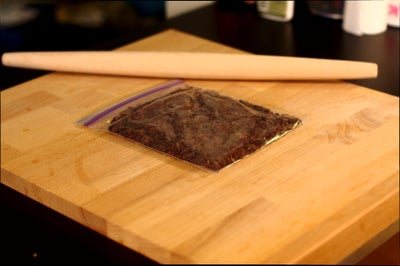
Now that the beans have cooled, the outsides (hulls) need to be separated from the insides (nibs).
There are two ways to do this. You can always peel each bean by hand, thrown away the skins, and keep the nibs for yourself. This will take a long time, but you lose very few nibs.
The other, faster option is to imitate the way these separations are done industrially – we’ll crack the beans up and blow air on them to separate the thin papery outside from the dense tasty inside.
Place the cocoa beans into a plastic bag, and crush them up with a rolling pin, cast iron skillet, or other similarly heavy object. Don’t be too gentle! Crack them beans!
Pour the mixture into a bowl. Next, gently direct the hairdryer towards the bowl. Agitate the cocoa mixture, either by stirring it with your hands or by shaking the bowl. If you’ve got the hairdryer at the right distance, the cocoa bean skins will fly out of the bowl, leaving the nibs behind. Check the nibs out to make sure all the skins are gone.
Oh, by the way – you should do this outside. And you might want to wear goggles.
Step 4: Refining the Cocoa

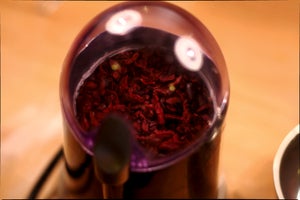

3 More Images
The next step in the process is to grind the roasted nibs into a smooth, uniform mass. You want to take the nibs and “refine” the cocoa solids into the smallest possible size particles that you can. The human tongue can detect particles larger than 30 microns (about a thousandth of an inch), so the smaller they get, the smoother the final product.
The best possible piece of equipment you could use for this would be a commercial chocolate melangeur or Indian flour grinder. Unfortunately, these are expensive and hard to obtain. You can also use a juicer, with the folks online generally picking a Champion brand juicer. Again, a masticating juicer is an expensive piece of equipment, and not something one would generally be expected to have at home.
So, in the stead of the more expensive machines, it’s possible to use a standard blade-type coffee/spice grinder to refine the chocolate. It’s unlikely that the grinder will be able to refine the mass all the way down to 30 microns, so the resulting chocolate might have a “sandy” mouthfeel; don’t despair, the taste will still be excellent!
First, we need to refine the desired sweetener. To do this, figure out how much chocolate you want to end up with (about 100 grams is really the maximum that my grinder can handle), and work from there. A 100 gram batch of 60% dark chocolate will require 60 grams of nibs and 40 grams of sugar. Add the sugar to the spice grinder and grind it until it’s a superfine powder.
Add in the nibs.
They’ll need to be processed for about 5 minutes total. If your spice grinder is like mine (cheap), it can’t handle 5 minutes of constant on-time. Grind for about a minute at a time, and give the gadget some cool-down time if it should start to feel warm.
At first, the grinder will reduce the nibs to a coffee ground-like consistency, but as the blade continues to grind and heat the mass the cocoa butter will melt and be released. This will cause the mass to take on a thick, tar-like appearance – at this stage, it will be necessary to scrape up the mass that is stuck to the bottom and sides of the grinder.
The grinding is done when the mass flows easily.
When the chocolate is refined as much as possible, spices can be added. Make sure that they’re thoroughly mixed into the mass!
If the chocolate needs thinning, small amounts of cocoa butter can also be added. Try to keep the total amount of additional cocoa butter below 10% of the total weight (no more than 10 grams for a 100 gram batch of chocolate).
Step 5: Conching the Chocolate

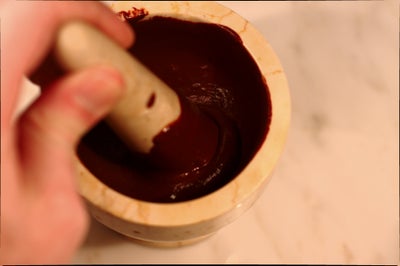
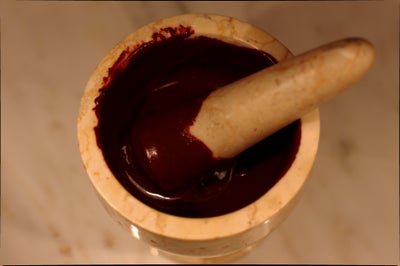
After refining, the chocolate needs to be “conched.”
Conching serves two purposes. First, it helps to drive off undesirable flavor compounds developed during fermentation and roasting, and it helps coat the cocoa solids with fat to reduce the viscosity of the molten chocolate.
In an industrial setting, chocolate is conched for several hours. Since we’re conching our chocolate by hand, this is, for lack of a better term, impractical. Still, even 10-15 minutes of conching will help un-harsh your chocolate’s mellow.
First, heat up the mortar and pestle, either by placing them into a warm oven for a few minutes, or with a hairdryer. Add the chocolate from the spice grinder, and grind away.
When is it done? When you’re happy with the taste, of course! Every 5 minutes or so, give the batch a taste. Once it tastes done, it’s done.
If you’ve made a large batch of chocolate (on the order of a pound or so), you can conch it effectively in a stand mixer. Fit the mixer with the paddle attachment, and whip the chocolate on a low speed for an hour or so. If the chocolate begins to thicken, heat it up with a hairdryer or by putting an incandescent lamp near the bottom of the bowl.
Step 6: Tempering the Chocolate
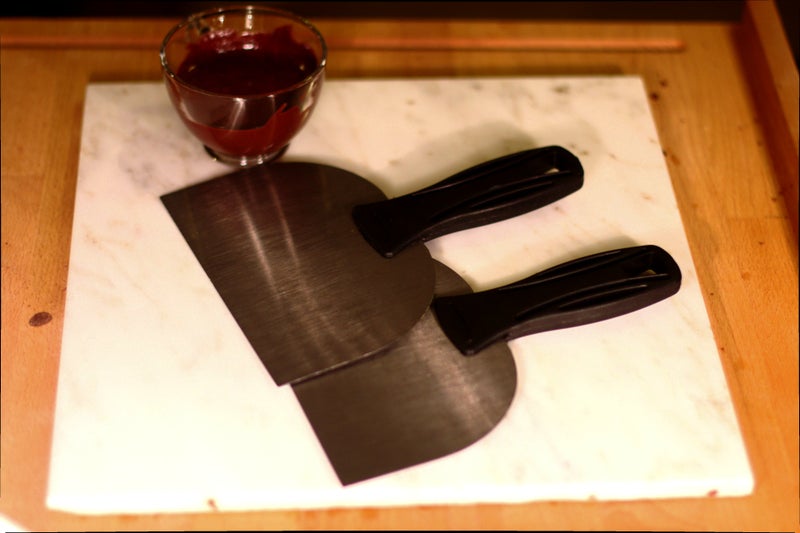
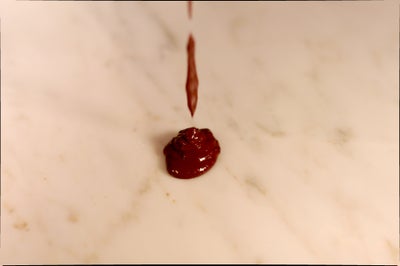
3 More Images
Tempering the chocolate is optional, but recommended.
Tempering is necessary because cocoa butter can crystallize into several different forms with differing stability and properties. Unless the cocoa butter is handled in a manner to encourage the formation of the most stable form (form V), the final product will have an inferior mouthfeel and texture, and may melt too quickly in the hand.
The easy way is to take a commercial sample of tempered chocolate and use the seeding method detailed in Scoochmaroo’s instructable to temper your chocolate. This is very effective, but you have to accept that your chocolate will be “contaminated” with the commercial stuff.
If you want to temper yours for the ultimate “from scratch” touch, you need to use the tabling method.
To table untempered chocolate, you need a stone slab and scraping tools.
Melt the chocolate to be tempered to at least 110 F, to melt all of the cocoa butter crystals.
Take about two thirds of the total batch and pour it onto the marble slab. Fold and agitate the chocolate with the scrapers, ensuring that no lumps form. Agitation encourages the formation of form V crystals to the exclusion of others.
Eventually, the chocolate will take on a thick, sludgy consistency. When it does, re-mix it into the remainder of the batch. At this point, you can pour the chocolate into molds.
